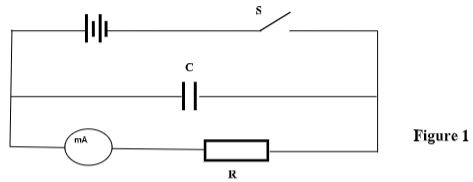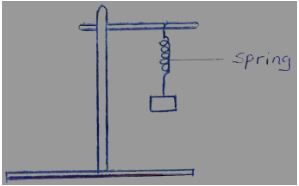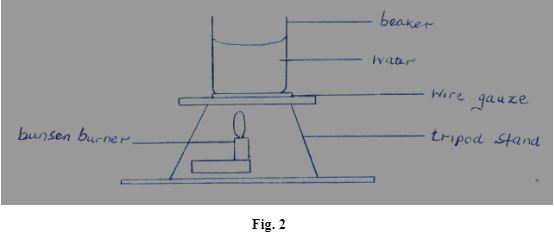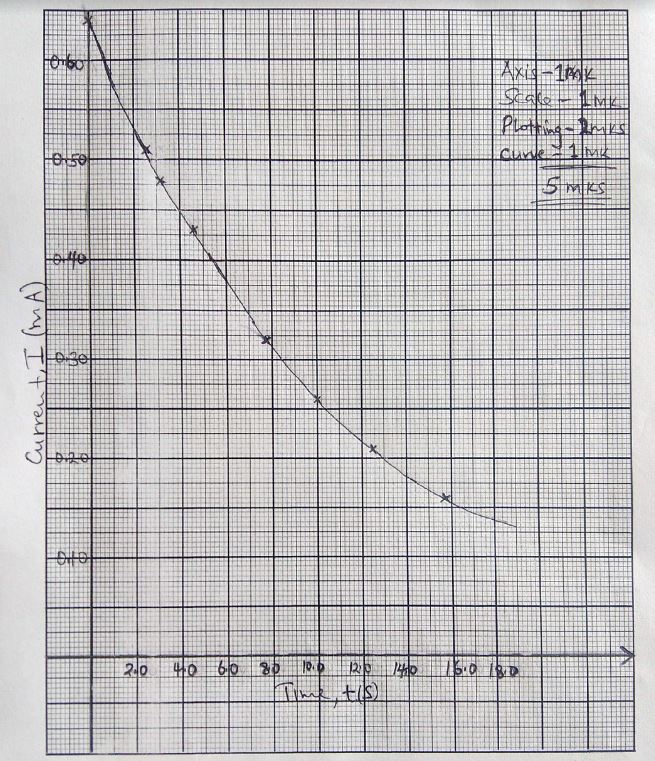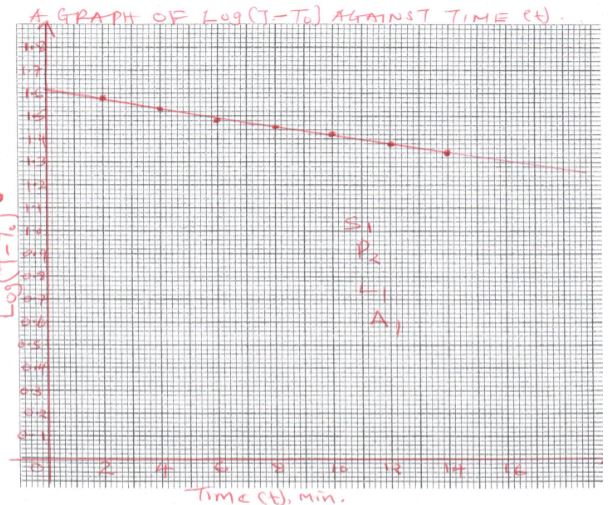Questions
INSTRUCTIONS TO CANDIDATES
- This paper consists of two questions 1 and 2.
- Answer all questions in the spaces provided.
- Non-programmable calculators and mathematical tables may be used.
- Show all your workings.
QUESTION ONE
You are provided with the following
- 2 new dry cell size D
- A cell holder
- A switch
- A milliameter of range 0 – 1mA
- A capacitor labelled C
- 8 connecting wires at least four with crocodile clips on one end
- A stop watch
- A carbon resistor labelled R
Proceed as follows- Connecting the circuit as shown in the figure 1 below, where P and Q are crocodile clips
- Close the switch S
- Record the highest reading of the milliammeter Io and then open the switch.
Io =………………………………………… (1 mark) - Use Io above to calculate 4/5Io, 3/4Io, 2/3Io, 1/2Io, 2/5Io, 1/3Io and 1/4Io. Record in the table 1 below.
- Close switch S for a second time and observe the deflection in the milliammeter (the pointer should rise back to the same initial value Io.)
- Open switch S and at the same time start the stop watch to measure the time taken for the current to decrease to four fifth the value of Io. i.e. 4/5Io. Record your value in the table 1 below.
- Repeat steps e and f for other values of current as shown on the table 1 below
(8marks)Current I (mA) Io 4/5Io 3/4Io 2/3Io 1/2Io 2/5Io 1/3Io 1/4Io Your calculated fraction of Io (mA) Time t (s) - Plot a graph of current I (y-axis) (mA) against time t (s) (5marks)
- From your graph, find W the value of I when t = 7.00s in SI units. (2marks)
- Given that A = 10W, determine the value of A. (1mark)
- Determine the voltage across R at t = 7.00s given that R = 4.7 KΩ (2marks)
- State the quantity represented by the area under the graph (1mark)
- Connecting the circuit as shown in the figure 1 below, where P and Q are crocodile clips
QUESTION TWO
This question has two parts A and B. Answer both parts.
PART A
You are provided with the following:-
- A retort stand, clamp and boss.
- A spiral spring.
- A stop watch.
- Three 100g masses.
Proceed as follows:
- Suspend a 100g mass at the end of the spring as shown in figure 1.
Now give the mass a small vertical displacement and release so that it performs vertical oscillations. Time ten oscillations and determine the period T. Enter your results in table 1. - Repeat the experiment for the other values of mass and complete the table.
Table 1
(3mks)Mass m (g) 100 200 300 Time for 10 oscillations (s) Periodic time T(s) - Given that T = π √m/k , where k is the spring constant, find the average value k for the spring. K (2mks)
PART B
You are provided with the following:-
- A 250ml glass beaker
- A Bunsen burner
- A Thermometer
- A Stop watch
- A Tripod stand and a Wire gauze
- A measuring cylinder 100ml
- Water
Set the apparatus as shown in figure 2 below.- Measure 100cm3 of water and pour it into the beaker. Take the initial temperature of the water.
T0 = …………………………………………….0C (1mk)
Now heat the water to a temperature of 80°C. switch off the gas tap and place a thermometer into the beaker and start the stop watch when the temperature is 65°C. Take the temperature T°C of water ever two minutes. Record your results in the table 2 below.
Table 2
(5mks)Time, t(min) 2 4 6 8 10 12 14 Temperature (T) °C (T - T0) Log (T - T0) - Plot a graph of Log (T - T0) against Time (t). (5mks)
- Find the value of P of log (T - T0) when t = 0. (1mk)
- Determine N, where N is the antilog of P. (1mk)
- Calculate the temperature of the surrounding TR using the expression N = 65–TR (2mks)
- Measure 100cm3 of water and pour it into the beaker. Take the initial temperature of the water.
Confidential
INSTRUCTIONS TO SCHOOLS:
- The information contained in this paper is to enable the head of school and the teacher in charge of Physics to make adequate preparation for this Physics practical examination. NO ONE ELSE should have access to this paper or acquire knowledge of its contents. Great care MUST be taken to ensure that the information herein does not reach the candidates either directly or indirectly.
- The apparatus required by each candidate for the Physics Practical examination are set out on below. It is expected that the ordinary apparatus of a Physics laboratory will be available.
- The Physics teacher should note that it is his/her responsibility to ensure that each apparatus acquired for this examination agrees with the specifications as indicated on the list of apparatus below.
- The question paper will not be opened in advance.
- The Physics teacher is not expected to perform the experiments.
NB: Any use of apparatus other than the ones specified may lead to candidates being
penalized.
QUESTION ONE
- 2 new dry cell size D
- A cell holder for two cells
- A switch
- A milliameter of range 0 – 1mA
- A capacitor labelled C 2200µF and 25V
- 8 connecting wires at least four with crocodile clips on one end
- A stop watch
- A carbon resistor labelled R 4700Ω
QUESTION TWO
Each candidate should have:-
- A retort stand, clamp and boss
- A spiral spring
- A stop watch
Three 100g masses - A 250ml glass beaker
- A Bunsen burner
- A thermometer (-10 to 110°C)
- A tripod stand and wire gauze
- A measuring cylinder 100mll
- A source of heat
- Some water in a container about 500ml
Marking Scheme
QUESTION ONE
You are provided with the following
- 2 new dry cell size D
- A cell holder
- A switch
- A milliameter of range 0 – 1mA
- A capacitor labelled C
- 8 connecting wires at least four with crocodile clips on one end
- A stop watch
- A carbon resistor labelled R
Proceed as follows- Connecting the circuit as shown in the figure 1 below, where P and Q are crocodile clips
- Close the switch S
- Record the highest reading of the milliammeter Io and then open the switch.
Io = 0.64mA ± 0.05mA (1 mark) - Use Io above to calculate 4/5Io, 3/4Io, 2/3Io, 1/2Io, 2/5Io, 1/3Io and 1/4Io. Record in the table 1 below.
- Close switch S for a second time and observe the deflection in the milliammeter (the pointer should rise back to the same initial value Io.)
- Open switch S and at the same time start the stop watch to measure the time taken for the current to decrease to four fifth the value of Io. i.e. 4/5Io. Record your value in the table 1 below.
- Repeat steps e and f for other values of current as shown on the table 1 below
(8marks)Current I (mA) Io 4/5Io 3/4Io 2/3Io 1/2Io 2/5Io 1/3Io 1/4Io Your calculated fraction of Io (mA) 0.64 0.51 0.48 0.43 0.32 0.26 0.21 0.16 Each ½ mk
(use student value of Io )
Max 4 mksTime t (s) 0.00 2.57 3.34 4.72 7.87 10.09 12.55 15.88 ± 1.00 sec
Each ½ mk (2dp must)
Max 4mks - Plot a graph of current I (y-axis) (mA) against time t (s) (5marks)
- From your graph, find W the value of I when t = 7.00s in SI units. (2marks)
- W = 0.35mA
= 3.5 x 10-4 A
- W = 0.35mA
- Given that A = 10W, determine the value of A. (1mark)
- A = 10 x 3.5 x 10-4
= 3.5 x 10-3A
- A = 10 x 3.5 x 10-4
- Determine the voltage across R at t = 7.00s given that R = 4.7 KΩ (2marks)
- V=IR
= 3.5 x 10-3 x 4.7 x 10-3
= 16.45V
- V=IR
- State the quantity represented by the area under the graph (1mark)
- Quantity of charge in the capacitor
- Connecting the circuit as shown in the figure 1 below, where P and Q are crocodile clips
QUESTION TWO
This question has two parts A and B. Answer both parts.
PART A
You are provided with the following:-
- A retort stand, clamp and boss.
- A spiral spring.
- A stop watch.
- Three 100g masses.
Proceed as follows:
- Suspend a 100g mass at the end of the spring as shown in figure 1.
Now give the mass a small vertical displacement and release so that it performs vertical oscillations. Time ten oscillations and determine the period T. Enter your results in table 1. - Repeat the experiment for the other values of mass and complete the table.
Table 1
(3mks)Mass m (g) 100 200 300 Time for 10 oscillations (s) 4.75 6.74 8.02 Periodic time T(s) 0.475 0.674 0.0802 - Given that T = π √m/k , where k is the spring constant, find the average value k for the spring. K (2mks)
- K1 = 4.375, k2 = 4.346, k3 = 4.605
K = 4.442kg/m or 44.42N/m
- K1 = 4.375, k2 = 4.346, k3 = 4.605
PART B
You are provided with the following:-
- A 250ml glass beaker
- A Bunsen burner
- A Thermometer
- A Stop watch
- A Tripod stand and a Wire gauze
- A measuring cylinder 100ml
- Water
Set the apparatus as shown in figure 2 below.- Measure 100cm3 of water and pour it into the beaker. Take the initial temperature of the water.
T0 = 23.0°C (1mk)
Now heat the water to a temperature of 80°C. switch off the gas tap and place a thermometer into the beaker and start the stop watch when the temperature is 65°C. Take the temperature T°C of water ever two minutes. Record your results in the table 2 below.
Table 2
(5mks)Time, t(min) 2 4 6 8 10 12 14 Temperature (T) °C 61.0 57.0 53.0 51.0 49.0 47.0 45.0 (T - T0) 38.0 34.0 30.0 28.0 26.0 24.0 22.0 Log (T - T0) 1.580 1.531 1.477 1.447 1.415 1.380 1.342 - Plot a graph of Log (T - T0) against Time (t). (5mks)
- On the grid
Plotting P = 2mks
Scale S = 1mk
Labeling axes A = 1mk
Line L = 1 mk with -ve gradient
- On the grid
- Find the value of P of log (T - T0) when t = 0. (1mk)
- P = y- intercept
= 1.61 1mk
Evidence from graph
- P = y- intercept
- Determine N, where N is the antilog of P. (1mk)
- N = antilog of P
= antilog of 1.61
= 40.74° C
- N = antilog of P
- Calculate the temperature of the surrounding TR using the expression N = 65–TR (2mks)
- N = 65 - TR
40.74 = 65 - TR
TR = 24.26°C
- N = 65 - TR
- Measure 100cm3 of water and pour it into the beaker. Take the initial temperature of the water.
Download Physics Paper 3 Questions and Answers - ACK Diocese Mumias Joint Evaluation Mock 2022.
Tap Here to Download for 50/-
Get on WhatsApp for 50/-
Why download?
- ✔ To read offline at any time.
- ✔ To Print at your convenience
- ✔ Share Easily with Friends / Students

